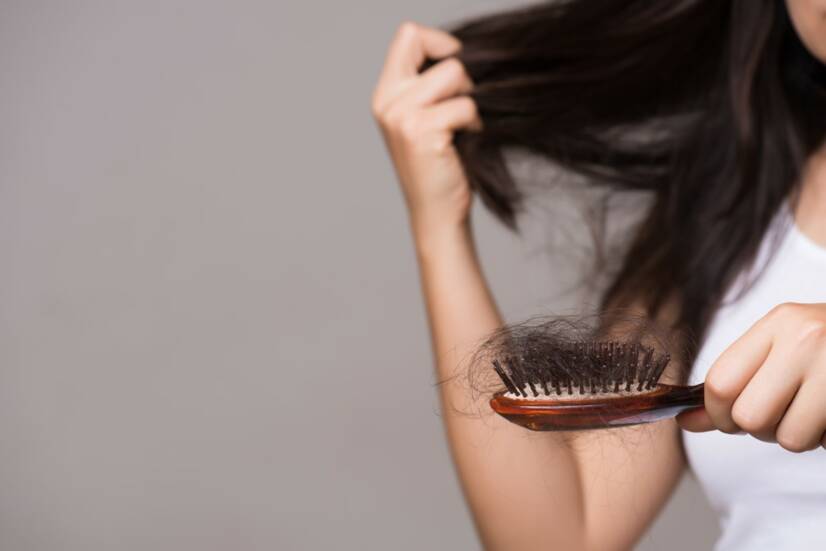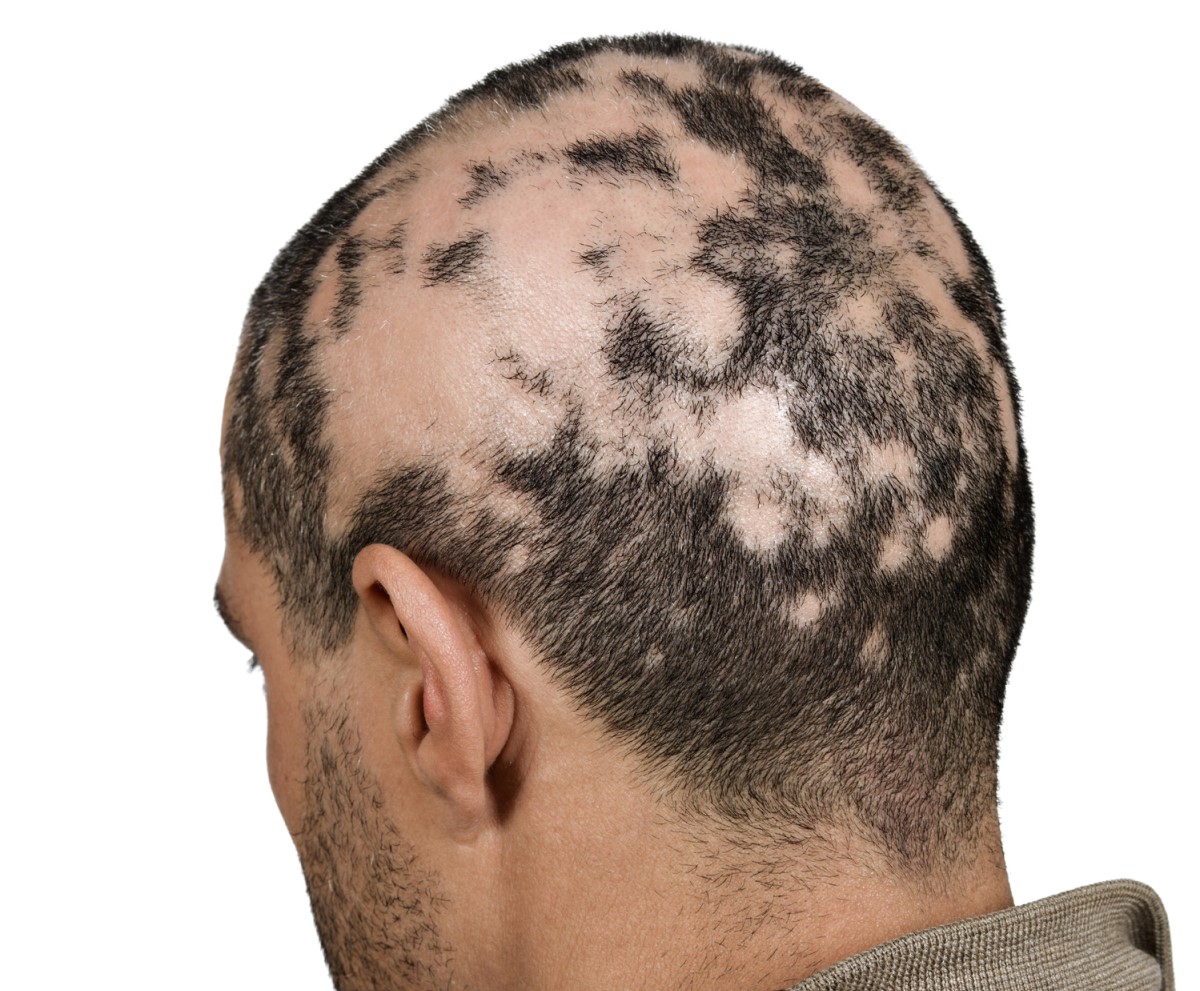- aafp.org - Hair Loss: Common Causes and Treatment
- ncbi.nlm.nih.gov - A Multimodal Hair-Loss Treatment Strategy Using a New Topical Phytoactive Formulation: A Report of Five Cases
- sciencedirect.com - New-Generation Therapies for the Treatment of Hair Loss in Men
Excessive Hair Loss: Causes, Treatment

Hair loss, also called alopecia, is one of the physiological and natural phenomena. However, when it is excessive, it may become a problem.
Hair loss is one of the physiological and natural phenomena. In a healthy person, each hair is in one of three phases. These three physiological phases include:
- anagen (the hair is in an active growth phase, about 90% of the hair),
- katagen (gradual degeneration of the hair, less than 10% of the hair)
- telogen (resting, last phase, 5% to 10% of hair).
During the telogen phase, the hair naturally falls out and the cycle starts all over again.
This implies that the fallen hair is replaced by a new hair.
However, there are situations when hair falls out excessively and new hair no longer grows in the areas where it is falling out. This creates areas of exposed, ungrown skin, also called bald patches.
Hair on the comb, the pillow, everywhere, only on the head is missing. When should we pay attention?
Excessive hair loss, also called alopecia, can occur in several forms, depending on whether the hair loss is caused by islands of baldness - alopecia areata, or whether the hair loss is caused by diffuse thinning - alopecia diffusa, or by telogen effluvium.

An important clinical phenomenon is the formation of scars in the hairy part of the head. If the hair loss does not cause scarring, it is so-called noncicatrial alopecia. This form of the disease is reversible.
If there is scarring, i.e. a cicatricial form, it may be an autoimmune disease, e.g. discoid lupus erythematosus. Scarring is caused by the destruction of the hair follicle by inflammation. It is recognised by the absence of follicular openings normally found after a hair has fallen out.
The unscarred form of alopecia is divided into local (islets) and diffuse (uniform thinning) alopecia. Uneven local hair loss is most commonly caused by alopecia areata, tinea capitis and trichotillomania.
Conversely, uniform diffuse hair loss, which causes gradual thinning of the hair, is usually caused by telogen or anagen effluvium.
Hormonal alopecia in men, also called androgenetic alopecia, is most often diffuse and can progress to complete baldness.
If hair starts to fall out in larger quantities, other systemic, accompanying symptoms should also be noticed. Fatigue and weight gain may indicate hypothyroidism.
Frequent unexplained fevers, stress, and postpartum status may predict diffuse hair loss in telogen effluvium.
Excessive use of hair styling products, frequent hair straightening or certain shampoos can cause a disease called trichorrhexis nodosa.
Baldness in male family members may simply be hereditary and is androgenetic alopecia.
A very unpleasant phenomenon is the loss of hair all over the body, the so-called alopecia universalis. This condition can be caused, for example, by cytostatic chemotherapy administered in the treatment of oncological diseases.
Dry, broken hair suggests trichorrhexis nodosa, while scaling, pustules, scabs, erosions or erythema, and local swelling of lymph nodes suggest infection.
You will be professionally examined by a dermatologist
Diagnostic tests for excessive hair loss include a simple so-called pull test. The doctor grasps approximately 40 to 60 hairs in special forceps, as close to the scalp as possible. By pulling away from the scalp, he tries to pull the hair out. A positive result of excessive falling is pulling more than 10% of the hair from the scalp.
The test is positive only in certain types of diseases, e.g. telogen effluvium, anagen effluvium or alopecia areata.
Overview of diseases causing excessive hair loss
The following are examples of diseases that cause excessive hair loss.
Androgenetic alopecia
It is the most common form of alopecia in men, but also in women. In principle, it is a physiological phenomenon, the symptom of which is excessive hair loss.
Androgenetic alopecia mainly affects Caucasians, usually after the age of 30. Approximately 50% of men in their fifties suffer from androgenetic alopecia. Heredity of hair loss is relatively common, especially in males.
In women, this type of alopecia is rarer. Approximately 38% of women over the age of 70 suffer from it.
In men, there is thinning in the area above the ears, hair loss on the front surface of the scalp and vertex skin. In women, the loss is diffuse, mainly on the top of the head, with hair retention above the frontal line.
Androgenetic alopecia can also mimic other diseases, e.g. hypothyroidism, iron deficiency anaemia or malnutrition.
Alopecia areata
Alopecia areata is an acute condition. Hair loss creates irregular islands of bare skin. It affects approximately 2% of the population, with no difference between the sexes, of which up to one fifth are children.
The cause of the disease is probably an autoimmune reaction. The disease may occur as a single event or have phases of remissions and relapses.
Alopecia areata can take three forms:
- Uneven alopecia that forms circumscribed and oval-shaped islands of skin on any part of the body.
- Alopecia totalis is characterized by affecting the entire scalp.
- Alopecia universalis causes loss of hair and body hair.
Under the microscope, hair follicles form the characteristic exclamation mark image, i.e. hairs that are narrow at the scalp and expand outwards to mimic an exclamation mark. Not infrequently, the nails may also be affected, on which tiny pits are visible.
Tinea capitis
Tinea capitis is an infectious disease. It is a dermatophyte infection of the hair shaft and follicles. It typically affects children who become infected by sharing combs, brushes, hats and other objects.
The causative agent that causes this disease is most often Trichophyton tonsurans, which is an infectious fungus whose particles are transmitted from person to person. Microsporum audouinii in turn is spread by infected dogs and cats.
The infected individual develops islet alopecia, which may form scales. It also causes itching and swelling of the lymph nodes, typically behind the ears.
When the diagnosis is unclear, a skin scrape from the affected and inflamed skin margin can be examined microscopically.
Telogen effluvium
Telogen effluvium is a non-inflammatory alopecia affecting both sexes at any age.
It is caused by the entry of a large number of hairs into the last telogen phase, during a relatively demanding and stressful period. Approximately three to five months after this psychologically demanding period, the hair suddenly falls out.
Stressful periods include, in addition to emotional strain:
- chronic diseases,
- pregnancy,
- surgeries,
- high fevers,
- malnutrition,
- serious infections,
- endocrine disorders.
In this type of alopecia, there is no redness of the skin, scaling, inflammation, change in length, shape or fragility of the hair.
Telogen effluvium usually passes on its own within about two to six months after the stressful situation has been overcome. If caused by emotional stress that is not addressed, hair loss can last for years.
Trichotillomania
Trichotillomania is a psychiatric disorder that can develop in the teenage years, around the age of 13. It affects about 4% of the population.
Young patients with this disease consciously or unconsciously pull, tear and twist their hair.
Gradually, islands of alopecia form, progressing from the forehead, behind the ears to the back of the head. Even the eyelashes or eyebrows are not spared.
Common complications of the disease include infection from dirty hands, scalp injury or permanent scarring of the scalp.
Trichorrhexis nodosa
Trichorrhexis nodosa causes hair loss with excessive hair breakage. The damage may be secondary and due to trauma or due to primarily brittle hair.
Secondary causes of damage include frequent hair washing, heat styling, tight haircuts, trichotillomania, and conditions that cause excessive scalp scratching.
Chemical damage to the hair is also a common cause, e.g. by bleaching, colouring, shampooing, perms or excessive bathing in salt water.
Trichorrhexis nodosa may also have a genetic (hereditary) cause. Examples are trichorrhexis invaginata called bamboo hair, Menkes disease, various keratinization defects due to defects in copper metabolism, and argininosuccinic aciduria.
Macroscopically, white nodules are visible on the hair. These are split and broken hair fibers. Under the microscope, the hair resembles a whisk.
Anagen effluvium
Anagenic effluvium is a term for abnormal, usually sudden, hair loss during the anagen, or first phase of hair growth. Hair loss is caused by a condition that disrupts the mitotic phase or metabolic activity of the hair follicle.
The most common such condition is treatment with chemotherapy drugs for cancer. Approximately 65% of patients treated with cyclophosphamide, nitrosourea and doxorubicin suffer from sudden hair loss of the entire head covering.
Alopecia is diffuse and begins several days to weeks after application of the chemotherapeutic agent. Complete hair loss is most evident after one to two months.
Hair loss during cancer treatment is one of the most traumatic experiences, especially for women. Up to 10% of women will refuse chemotherapy as a treatment for their cancer for fear of hair loss.
In addition to chemotherapy, other drugs also cause hair loss. Other drugs causing alopecia include:
- tamoxifen,
- alopurinol,
- levodopa,
- bromocriptine,
- toxins - bismuth, arsenic, gold
Anagen effluvium can also occur as a result of infectious and inflammatory diseases such as mycosis fungoides or pemphigus vulgaris.
Anagenic effluvium is fully reversible in the vast majority of cases. Hair will begin to re-grow after approximately one to three months after treatment is completed. Permanent and irreversible baldness is very rare.
Treatment of hair loss depends on the cause
Some types of alopecia, such as alopecia areata, can be treated by topical application of corticosteroids, minoxidil, anthralin, immunotherapy or systemically administered corticosteroids into a vein.
Infectious alopecia such as tinea capitis is treated with topical antifungals that penetrate to the hair follicle. Examples are intraconazole, fluconazole, griseofulvin or terbinafine.
Modern methods of treating androgenic alopecia include:
- Platelet-rich plasma.
- Cytokine injections.
- Low-frequency laser therapy.
- Nutraceuticals.
- Mikroneedling.
What about hair loss? Do home remedies help?
For seasonal hair loss, you can help yourself with grandmotherly recipes. For the overall improvement of hair quality, nettle and preparations containing its extracts, swallowwort, horseradish, brewer's yeast, horsetail and others are traditionally known.
We can also support the growth of healthy hair by taking various nutritional supplements, vitamins such as vitamin C, B-complex, vitamin D, A or vitamin E. Among the trace elements, zinc, copper and selenium have a positive effect on the strength of the hair.
Diseases with symptom "Hair Loss"
Herbs used forExcessive Hair Loss: Causes, Treatment
Interesting resources
Related










